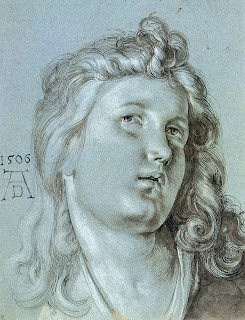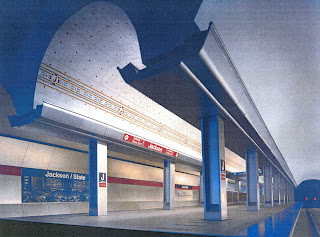1) Line
Lines can be seen in artwork all around. Though it's easiest to see lines in works that are mostly linear and two-dimensional, it is also seen in more complex works of art, such as the edges of sculptures. This is very evidently seen in the Washington Monument. There are different types of lines in art, such as implied line, descriptive line, expressive line, and directional line.
Implied lines are lines that aren’t physically created but are suggested by an artist. By looking at the work of art, the viewer can perceive lines where there aren’t any. Such an example of this is found in William Blake’s Glad Day.

Descriptive line is line that tells the physical nature of the object we see and how it exists in space. It is seen in the illusion of three-dimensional form in two-dimensional portraits, such as Albrecht Durer’s Head of an Angel.
Line can also have expressive qualities. For example, if lines are smooth and without sharp curves or turns, it can give one a sense of calmness. If, however, lines do have sharp curves, it could give the sense of excitement, anger, or danger. From lines we can often times sense the feelings that the artist is trying to express.
 Directional lines, as the name implies, are lines mainly used to direct the viewer’s attention to a certain direction, such as an anonymous artist’s rendition of the Jackson State subway platform.
Directional lines, as the name implies, are lines mainly used to direct the viewer’s attention to a certain direction, such as an anonymous artist’s rendition of the Jackson State subway platform.Shape and form can refer to the two- and three-dimensional works of art, respectively. Shapes are relatively flat areas. Artists work with both hard- and soft-edged shapes. In hard-edged shapes, the shapes boundaries are easily recognized and differentiated from surrounding areas. In contrast, in pieces with soft-edged shapes, it’s not always easy to tell where one shape stops and another begins, such as in the portrait made by Anne Whitfield.
3) Space
Space is the physical space that a piece of art occupies. Some three-dimensional sculptures choose to create large pieces that fill a great amount of space, and others create their own little world in a confined space. In a two-dimensional artwork, the surface is defined by a flat plane.
Some devices used to make two-dimensional pieces seem like they have depth are: placement, where objects are situated in different places around one another to make some seem closer and some seem further away; scale change, where closer objects would be larger, while far off objects would be drawn much smaller; linear perspective, where all parallel horizontal lines that recedes from the viewer goes diagonally towards the same vanishing point; atmospheric perspective, where things in the distance are less defined in form, hues, and value contrast than things closer to the viewer; point of view, where the viewer is placed in an exact position in relation to the objects in the picture; and aerial view, where the view is above the scene that is shown.
shown.
Some devices used to make two-dimensional pieces seem like they have depth are: placement, where objects are situated in different places around one another to make some seem closer and some seem further away; scale change, where closer objects would be larger, while far off objects would be drawn much smaller; linear perspective, where all parallel horizontal lines that recedes from the viewer goes diagonally towards the same vanishing point; atmospheric perspective, where things in the distance are less defined in form, hues, and value contrast than things closer to the viewer; point of view, where the viewer is placed in an exact position in relation to the objects in the picture; and aerial view, where the view is above the scene that is
 shown.
shown.4) Texture
The texture of a work is its surface quality. It is how it would feel if we touched it. Artists use texture to influence the viewers’ response to a piece of art. Some pieces are more inviting than others; for example, a smooth piece such as a marble bust of Caesar is much more texturally inviting than a rough-looking ancient artifact.

5) Value and Light
Value is the relative lightness or darkness of an area. Such values are based on a value scale, which has ten equal steps, black on one end and white on the other. The actual lights and shadows we see on real surfaces are called local values. When values are not depicted realistically, they are called interpretive values.
Lighting is the way a subject is hit by the sun or by artificial light. Lighting can add much to a piece of art. It can reflect what time of day it is, or what kind of setting the subject is in. Reflections are also used to capture attention.
6) Color
Though color may seem just like a normal element of artwork, it has great effects on our visual receptors, emotional state, and perceptions of space. The color wheel is an important concept in art, and consists of three main hues which all others can be mixed. In art, there are different forms of color artists can use: natural and applied color, which is color we see around us and use to depict natural landscapes or objects; local color, the color something appears if seen under normal light; atmospheric color, conveying, not the colors an object is mentally perceived, but how it is when changed by the atmosphere; and interpretive color, color that is chosen as the artist’s intent rather than the real colors of the object.
7) Time
In art there can be actual movement in a piece. These types of works, where they can move through space, are called kinetic sculptures, such as the one made by David C. Roy (http://www.youtube.com/watch?v=nUuKNP6p_w0). There can also be an illusion of movement in two-dimensional pieces, such as in Fight or Flight by Saskia Ozols E
 ubanks.
ubanks.Artists can also capture a movement in time, or can depict change through time.
So we see from all these visual elements that artists have many techniques to help convey their art in a way that will help viewers to grasp the purpose of such meaningful works.


No comments:
Post a Comment